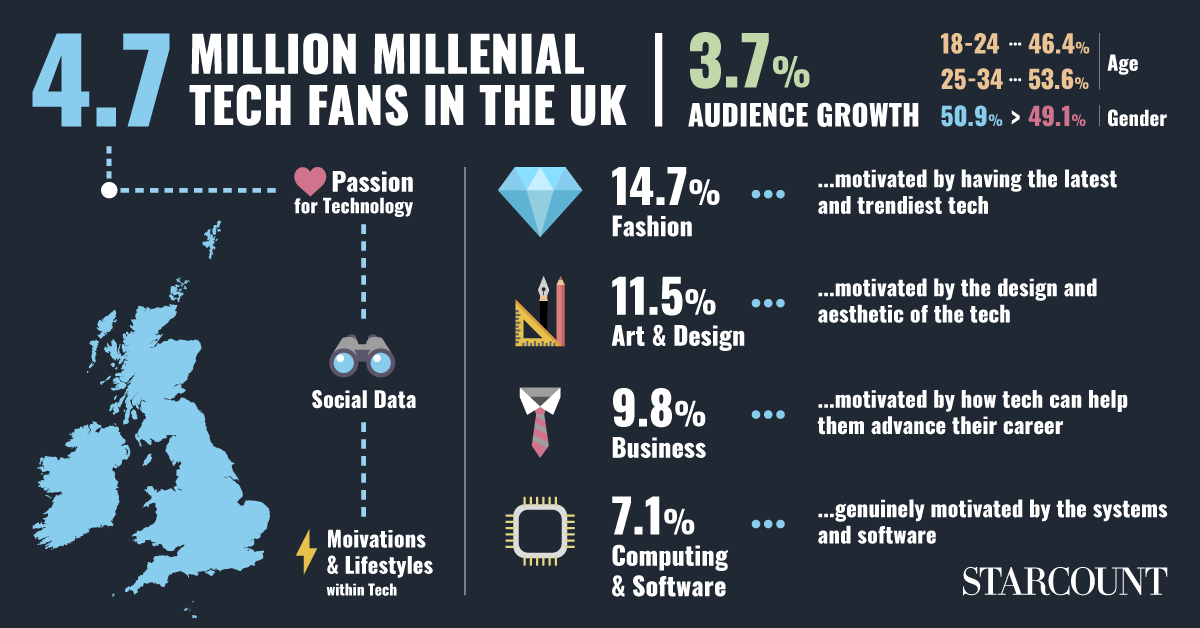Insights
New data for new tech: staying ahead in consumer electronics
The current technological revolution has brought consumer products and services of every variety to help improve, aid and entertain our lives. More electronics mean more digitisation and the gap between the physical and digital human experience continues to narrow. The supply of better, faster more powerful consumer electronics is seemingly never-ending, but, besides our quest to simplify our increasingly complex lives what are consumers really looking for from the industry? Here we have chosen some of the main themes of 2019 (wearable tech & smart TVs) and looked into what makes consumers buy these products.
Wearables – Fashion or functionality?
Staying up to date with technological developments is now essential for consumers to maintain a fast-paced lifestyle. The CES (Consumer Electronics Summit) of 2019 at the start of this year gave us a look into the future of the TV market and wearable technology to name but a few. The Starcount lens has some insight to offer on the audiences of these consumer trends, helping retailers understand the needs of their customers.
“Style plays a very important role for many consumers, who seek beauty, status and peer approval from their gadgets.”
Initially dismissed as a novelty following a number of high profile missteps, wearable products have since seen a resurgence with experts forecasting the market to be worth £39 billion by 2022. At Starcount, we analysed the passions and influences of 4.7 million Millennial tech fans in the UK, united in their passion for technology and the results revealed that the most closely associated passion to wearable technology was fashion (14.7%) as well as art & design (11.6%). Strangely, this was ahead of fitness & nutrition (4.7%) a passion which saw an increase of only 0.6% amongst the millennial tech community in the past few months. Wearables may be tech-minded but style plays a very important role for many consumers, who seek beauty, status and peer approval from their gadgets.
One of the main challenges for the marketers of wearable technology is to differentiate these devices. A smartwatch by a luxury fashion brand like TAG Heuer or Mont Blanc has a different design and market position than health-focused brands such as Fitbit.
Knowing how consumers categorise each product is particularly important for brands to adapt their retail settings and promotional activities to emphasise the needs of their shoppers.
TVs – A new era is around the corner
The TV market has somewhat stagnated for a while, but the latest innovations like 8K, AI, and Micro LEDs are about to introduce a new generation of TVs to monopolize consumers’ attention. Tracking and understanding how these innovations are perceived by their target markets will be of pivotal importance for the biggest consumer electronics brands to build their strategies.
“The Samsung audience is unusually brand loyal and less affected by media channels and influencers.”
Starcount’s market-leading product The Observatory was able to delve into the Samsung audience and reveal what is motivating customers to purchase. By using social clustering methods to analyse the social data of over 1.3 billion global consumers, Starcount was able to understand more about the interests, motivations and lifestyle patterns of this audience. The results show a diverse range of interests including fashion, shopping and finance — this audience are career-minded, up-to-date and like to look good.
Additionally, we have found that the Samsung audience is unusually brand loyal and less affected by media channels or influencers — they’re on the lookout for the next product release from their favourite brand. Analysing this valuable data helps companies to realise what they can bring to the table in the future and what will resonate best with their audience.
Leveraging social data
Consumers today expect brands to know them and recognise their individual needs. The CES 2020 is expected to focus around smart home technology, household robotics and sustainability products like low-energy fridges and meat replacements — who knew a burger would make it into a technology exhibition?
These consumer audiences have a diverse set of passions and motivations ranging from fashion to business to sustainability concerns. Consumer electronics companies will need to accommodate all these groups if they are to stay ahead – they need to target their customers, using what matters: people’s motivations and mindsets.
Leveraging social data (which is dynamic compared to demographic data) presents a unique picture that is updated in real-time and reveals what people love in order to predict what they will buy. Being relevant to customers and providing them with the right message, through the right channel, in the right place, at the right time means brands can engage customers, encourage brand loyalty and grow their market share.

